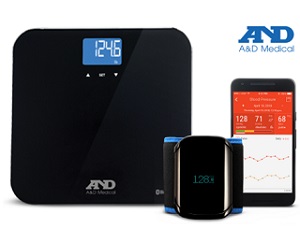
A&D Medical
Since 1977, A&D Medical has manufactured and distributed a full line of advanced biometric monitoring solutions including blood pressure monitors, weight scales, activity monitors, and other health monitoring devices for consumer and professional use. A&D Medical is a worldwide leader in connected health and biometric measurement devices and services for consumer wellness and chronic condition management, marketing under the A&D Medical brand globally, as well as the LifeSource brand in North America.
A&D Medical is a division of A&D Company, Limited, a global manufacturer of measurement equipment, with operations in Asia, Europe, Australia, Russia, North America, and South America. A&D Medical (Americas) is headquartered in San Jose, CA.
Guidelines
FAQ
General Blood Pressure Information
What is Blood Pressure?
Blood pressure is the force exerted by blood against the walls of the arteries. Systolic pressure occurs when the heart contracts; diastolic pressure occurs when the heart expands. Blood pressure is measured in millimeters of mercury (mmHg).
What is Hypertension?
Hypertension (also known as high blood pressure) is the diagnosis given when blood pressure readings consistently rise above normal. It is a serious condition that well known that hypertension can lead to coronary heart disease, stroke, heart attack, kidney failure, and other health problems or other illness if left untreated. Referred to as a “silent killer” because it does not always produce symptoms that alert you to the problem, hypertension is treatable when diagnosed early. Learn more here.
Can Hypertension by controlled?
In many individuals, hypertension can be controlled by altering lifestyle and minimizing stress, and by appropriate medication prescribed and monitored by your doctor. The American Heart Association recommends the following lifestyle suggestions to prevent or control hypertension:
- Don’t smoke.
- Reduce salt and fat intake.
- Maintain proper weight.
- Exercise routinely.
- Have regular physical checkups
- Monitor your blood pressure at periodic intervals.
What Affects Blood Pressure?
Blood pressure is affected by many factors: age, weight, time of day, activity level, climate, altitude and season. Certain activities can significantly alter one’s blood pressure. Walking can raise systolic pressure by 12 mmHg and diastolic pressure by 5.5 mmHg. Sleeping can decrease systolic blood pressure by as much as 10 mmHg. Taking your blood pressure repeatedly without waiting an interval of 5 minutes between readings, or without raising your arm to allow blood to flow back to the heart, can also affect it.
In addition to these factors, beverages containing caffeine or alcohol, certain medications, emotional stress and even tight-fitting clothes can make a difference in the readings. Read more information from the AHA here.
Why measure blood pressure at home?
For many individuals, blood pressure readings taken in a doctor’s office or hospital setting might may be elevated as a result of apprehension and anxiety. This response is commonly called “white coat hypertension.”
The AHA and the AMA both recommend self-measurement at home to supplement in office readings to rule out “white coat hypertension” and provide a more accurate, complete blood pressure history.
Clinical studies have shown that the detection and treatment of hypertension is improved when patients both consult their physicians and monitor their own blood pressure at home.
What is a baseline measurement?
The most important method to get an accurate blood pressure measurement is consistency. To get the most benefit out of your monitor, it is important to establish a “baseline measurement.” This helps build a foundation of measurements that you can use to compare against future readings. To build this baseline measurement, devote two weeks for consistent blood pressure monitoring. This involves doing everything the same way when you measure (e.g. measuring during the same time of day, in the same location, sitting in the same chair, using the same cuff, etc.). Once you establish your baseline measurement, you can start evaluating if your measurement has been affected based on things lifestyle changes or medication treatment.
How do I record my blood pressure?
Blood pressure readings are typically recorded with the systolic pressure written first, followed by a slash mark and the diastolic pressure. For example, 120 mmHg systolic and 80 mmHg diastolic measurements are written as 120/80. Pulse is simply written with the letter “P” followed by the pulse rate—P 72, for example. You can also download the A&D Connect app (free on iOS and Android) to digitally log your readings.
Blood Pressure Measurement Accuracy
Are your blood pressure monitors FDA approved?
All of A&D’s blood pressure monitors have FDA clearance. This is a requirement to sell in the US market. Learn more about Clinical Validation here.
My reading seems high. Is something wrong with the monitor?
Many factors can impact your blood pressure readings, including that your cuff might be too small. A cuff that is too small yields a measurement that is higher than the correct blood pressure. Be sure to check that you are using the correct cuff size before taking your blood pressure. Please reference the section called “Select the correct cuff” in the instruction manual or see “How do I know which cuff size will fit me?” to determine your correct cuff size. If your measurements still seem high, please consult your physician.
Why do my blood pressure readings vary so much during the day?
An individual’s blood pressure varies greatly (as much as 30 to 50mmHg) from day to day and season to season due to various conditions during the day. For hypersensitive individuals, these variations are even more pronounced. Normally, blood pressure rises during work or play and falls to its lowest levels during sleep. For example:

The best way to get consistent readings is to monitor your blood pressure at least once a day at the same time so that you can minimize the effect that external factors have on the reading.
Please consult your physician immediately if you have any doubt about your readings.
Why are my readings different between home and at a doctor’s office?
Your blood pressure readings taken in a doctor’s office or hospital setting may be elevated as a result of apprehension and anxiety. This response is known as “white coat hypertension”.
When I bring my home monitor to a doctor’s office, why do I get a different measurement than what’s taken by a doctor or nurse?
The healthcare professional may be using a different sized cuff. The size of the bladder inside the cuff is critical for the accuracy of the measurement. This may give you a different reading. A cuff too large will produce a reading that is lower than the correct blood pressure; a cuff that is too small will produce a reading that is higher than the correct blood pressure. There may also be other factors that can cause the difference in measurements.
Cuff Sizing
I am told I need to use a large cuff, but I fit into a standard. Can I still use a standard cuff?
Although you fit into a smaller cuff, you need to use the correct one to ensure an accurate reading. If your cuff is too small, your blood pressure reading will be artificially high. If your cuff is too large, you may get a reading that is lower than your actual blood pressure.
Please consult your physician immediately if you have any doubt about your readings.
Can a digital cuff work on an aneroid unit?
No. Digital and aneroid units use different type cuffs. Digital cuffs have one hose and aneroid cuffs have two hoses.
How do I know which cuff size will fit me?
With your arm hanging at the side of your body, measure the circumference of your upper arm at the midpoint between the shoulder and elbow. See the table below to find which blood pressure monitor will fit you.
| Model | Cuff Size (in) | Cuff Size (cm) |
| UA-705V | 9.4 – 14.2in | 23 – 36cm |
| UA-705VL | 14.2 – 17.7in | 36 – 45cm |
| UA-611 | 9 – 14.6in | 23 – 37cm |
| UA-767F Series | 8.6 – 16.5in | 22 – 42cm |
| UA-767 Pro Series | 6.3 – 9.4in | 16 – 24cm |
| UA-789AC | 16.5 – 23.6in | 42 – 60cm |
| UA-787EJ | 9 – 17in | 23 – 43cm |
| UA-1030T | 9 – 14.6in | 23 – 37cm |
| UA-651BLE | 9 – 14.6in | 23 – 37cm |
Using the correct cuff size is important for an accurate reading. A cuff that is too large will produce a reading that is lower than the correct blood pressure; a cuff that is too small will produce a reading that is higher than the correct blood pressure.
What is the Cuff Size Indicator on the cuff?
Our cuff has an indicator which tells you whether you are using the correct cuff size or not. Place the cuff on your arm, and if the Index Mark points within the Proper Fit Range, you are using the correct cuff size. If the Index points outside of the Proper Fit Range, contact us at 1-888-726-9966 for more information on where to obtain a cuff replacement.
NOTE: If the cuff size indicator falls on a borderline between two size categories, pick either one and make sure to use the same cuff size for each measurement.
Monitor Features
What is an irregular heartbeat?
An irregular heartbeat is defined as a heartbeat that varies from the average of all heartbeats during the blood pressure measurement. It is important that you are relaxed, remain still and do not talk during measurements.
All A&D Medical/LifeSource blood pressure monitors will alert you to the presence of an irregular heartbeat, either on the monitor’s screen or in the A&D Connect app. Please contact your physician if you see this symbol frequently.
What is the Average Reading feature?
Several A&D Medical blood pressure monitors offer an average blood pressure reading feature based on the total measurements stored in memory. When taking a measurement, the average blood pressure reading will appear and the number of measurements stored in memory will flash several times before the cuff begins to inflate. The average blood pressure reading will also appear briefly when you recall the measurements stored in memory.
What is the Pressure Rating Indicator feature?
The Pressure Rating Indicator™ is a feature which provides a snapshot of your blood pressure classification based on your measurements. This will let you quickly know what your blood pressure readings mean. Please see the JNC7 and AHA classifications below:
| JNC 7 | Systolic (mmHg) | Diastolic (mmHg) | |
| Normal | <120 | and | <80 |
| Prehypertension | 120-139 | or | 80-89 |
| Hypertension, Stage 1 | 140-159 | or | 90-99 |
| Hypertension, Stage 2 | ≥160 | or | ≥100 |
| AHA | Systolic (mmHg) | Diastolic (mmHg) | |
| Normal | <120 | and | <80 |
| Elevated | 120-129 | and | <80 |
| Hypertension, Stage 1 | 130-139 | or | 80-89 |
| Hypertension, Stage 2 | ≥140 | or | ≥90 |
| Hypertensive Crisis (consult your doctor immediately) | ≥180 | and/or | >120 |
NOTE: Due to other risk factors (e.g. diabetes, obesity, smoking, etc.) in addition to your blood pressure measurement, the Pressure Rating Indicator is approximate. Please consult with your physician for interpretation and diagnosis of your blood pressure measurements.
What do the symbols on my monitor mean?
Each monitor has a different set of features, so please refer to your Instruction Manual for a list of symbols and their meanings. We have included the Instruction Manuals on this website for your convenience. Please search your model in the search bar, then click on the matching product and scroll to the Downloads tab to see your manual.
